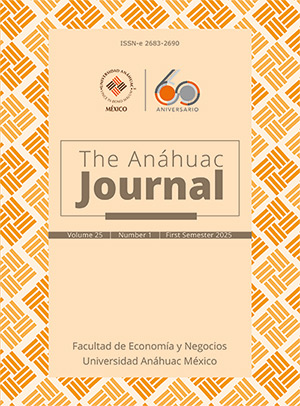Non-efficiency in Automated Markets for the US and Mexico
Main Article Content
Abstract
This work analyzes the Efficient Markets Hypothesis (EMH) introduced by Fama (1970). The notion has been a cornerstone in theory and practice in financial markets, given its implications for predicting future prices. The efficiency of markets has been widely explored in the literature. Still, recent technological advances have made it possible to trade faster than ever. Hence, the question arises again to examine the efficiency of high-frequency markets, which has not yet been investigated in depth. The present work explores market efficiency at various frequencies, from 1 second to 10 days, in the United States (US) and Mexico’s stock markets. The empirical distribution and correlation of the assets return series were modeled to try and gauge whether markets follow a random walk. Thus, one can conclude that information is instantly incorporated, and the market is efficient. Results show that the markets are not efficient for high frequencies, but above the 10-day threshold, these series follow a random walk with an asymptotically normal distribution. The conclusion is important for practitioners and academics since it suggests the possibility of forecasting prices in high frequencies using statistical tools.
Downloads
PLUMX Metrics
Article Details

This work is licensed under a Creative Commons Attribution-NonCommercial-ShareAlike 4.0 International License.
This work is licensed under a Creative Commons Atribución-NoComercial-CompartirIgual 4.0 Internacional.
References
Bessembinder, H., & K. Chan. (1998). Market Efficiency and the Returns to Tech- nical Analysis. Financial Management, 27(2): 5–17. https://www.jstor.org/sta-ble/3666289
Budish, E., Cramton, P., & Sim, J. (2015). The High-Frequency Trading Arms Race: Frequent Batch Auctions as a Market Design Response. The Quarterly Journal of Economics, 130(4), 1547–1621. https://doi.org/10.1093/qje/qjv027
Brogaard, J., Hendershott, T., & Riordan, R. (2014). High-Frequency Trading and Price Discovery. The Review of Financial Studies, 27(8), 2267–2306. https://doi.org/10.1093/rfs/hhu032
Chen, K., & Li, X. (2006). Is Technical Analysis Useful for Stock Traders in China? Evi- dence from the SZSE Component A-Share Index. Pacific Economic Review, 11(4): 477–488. https://doi.org/10.1111/j.1468-0106.2006.00329.x
Danak, D., & Patel, N. (2020). A Study of Efficiency of Index Futures, Lead-Lag Rela- tionship, and Speed of Adjustments in India Using Hgh-Frequency Data. Indian Journal of Finance, 14(4), 7–23. https://doi.org/10.17010/ijf/2020/v14i4/151705
Fama, E. F. (1970). Efficient Capital Markets: A Review of Theory and Empirical Work. The Journal of Finance, 25(2), 383–417. http://dx.doi.org/10.2307/2325486
Fifield, S., D. Power, & D. Sinclair. (2005). An Analysis of Trading Strategies in Eleven European Stock Markets. European Journal of Finance, 11(6): 531–548. https://doi.org/10.1080/1351847042000304099
Ftiti, Z., Jawadi, F., Louhichi, W., & Madani, M. E. A. (2020). Are Oil and Gas Futures Markets Efficient? A Multifractal Analysis. Applied Economics, 53(2), 164–184. https://doi.org/10.1080/00036846.2020.1801984
Gnedenko, B. V., & Kolmogorov, A. N. (1968). Limit Distributions for Sums of Independ- ent Random Variables. Addison-Wesley.
Gopikrishnan, P., Plerou, V., Nunes Amaral, L. A., Meyer, M., & Stanley, H. E. (1999). Scaling of the Distribution of Fluctuations of Financial Market Indices. Physical Review E 60(5), 5305–5316. https://doi.org/10.1103/PhysRevE.60.5305
Heng, P., Niblock, S. J., Harrison, J. L., & Hu, H. (2020). The Impact of High-Frequency Trading on Australian Futures Market Liquidity and Efficiency. Journal of Deriva- tives, 27(4), 51–76. https://doi.org/10.3905/jod.2020.1.097
Jarque, C. M., & Bera, A. K. (1980). Efficient Tests for Normality, Homoscedasticity and Serial Independence of Regression Residuals. Economics Letters, 6(3), 255–259. https://doi.org/10.1016/0165-1765(80)90024-5
Karemera, D., K. Ojah & J.A. Cole. (1999). Random Walks and Market Efficiency Tests: Evidence from Emerging Equity Markets. Review of Quantitative Finance and Ac- counting, 13(2), 171–188. https://doi.org/10.1023/A:1008399910942
Koutrouvelis, I. A. (1981). An Iterative Procedure for the Estimation of the Param- eters of Stable Laws. Communications in Statistics—Simulation and Computation, 10(1), 17–28. https://doi.org/10.1080/03610918108812189
Kristoufek, L., & M. Vosvrda. (2013). Measuring Capital Market Efficiency: Global and Local Correlations Structure. Physica A: Statistical Mechanics and Its Applications, 392(1): 184–193. https://doi.org/10.1016/j.physa.2012.08.003
Lahrech, A., & Sylwester, K. (2011). US and Latin American Stock Market Link- ages. Journal of International Money and Finance, 30(7), 1341–1357. https://doi.org/10.1016/j.jimonfin.2011.07.004
Leone, V., & F. Kwabi. (2019). High Frequency Trading, Price Discovery and Market Ef- ficiency in the FTSE100, Economics Letters, 181, 174–177. https://doi.org/10.1016/j.econlet.2019.05.022
Ljung, G. M., & Box, G. E. (1978). On a Measure of Lack of Fit in Time Series Models. Biometrika, 65(2), 297–303. https://doi.org/10.1093/biomet/65.2.297
Mensi, W., Lee, Y., Al-Yahyaee, K. H., Sensoy, A., & Yoon, S. (2019). Intraday Down- ward/Upward Multifractality and Long Memory in Bitcoin and Ethereum Markets: An Asymmetric Multifractal Detrended Fluctuation Analysis. Finance Research Let- ters, 31, 19–25. https://doi.org/10.1016/j.frl.2019.03.029
Mishra, S. (2019). Testing Martingale Hypothesis Using Variance Ratio Tests: Evidence from High-Frequency Data of NCDEX Soya Bean Futures. Global Business Review, 20(6), 1407–1422. https://doi.org/10.1177/0972150919848937
Mobarek, A., A. Sabur, & R. Bhuyan. (2008). Market Efficiency in Emerging Stock Mar- ket: Evidence from Bangladesh. Journal of Emerging Market Finance, 7(1): 17–41. https://doi.org/10.1177/097265270700700102
Picardo, E. (2014, June 2). Top Stocks High-Frequency Traders (HFTs) Pick (BAC,F,CSCO,INTC). HedgeChatter. Retrieved on October 26, 2020 from: https://www.hedgechatter.com/top-stocks-high-frequency-traders-hfts-pick-bacfcscointc/
Plerou, V., Gopikrishnan, P., Nunes Amaral, L. A., Meyer, M., & Stanley, H. E. (1999). Scaling of the Distribution of Price Fluctuations of Individual Companies. Physical Review E, 60(6), 6519–6529. https://doi.org/10.1103/PhysRevE.60.6519
Ratner, M., & Leal, R. P.C. (1999). Tests of Technical Trading Strategies in the Emerg- ing Equity Markets of Latin America and Asia. Journal of Banking and Finance, 23(12): 1887–1905. https://doi.org/10.1016/S0378-4266(99)00042-4

